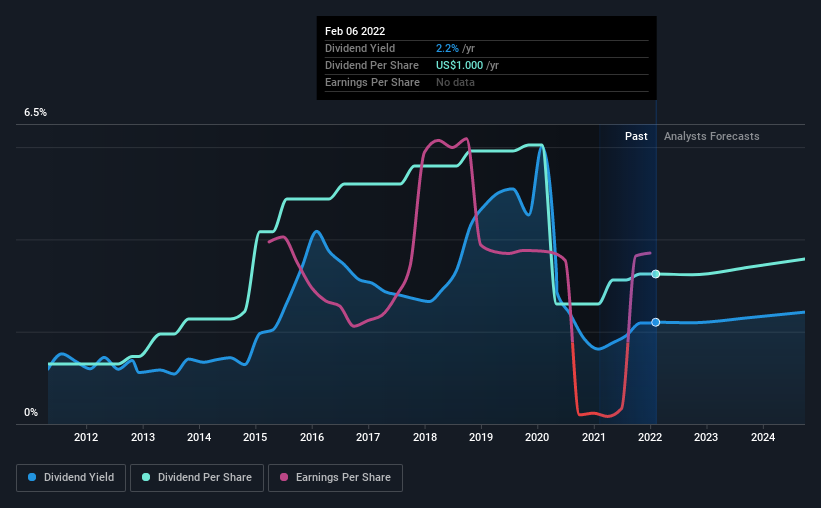WestRock Company (NYSE:WRK) stock is about to trade ex-dividend in two days. The ex-dividend date is one business day before a company's record date, which is the date on which the company determines which shareholders are entitled to receive a dividend. The ex-dividend date is important because any transaction on a stock needs to have been settled before the record date in order to be eligible for a dividend. Accordingly, WestRock investors that purchase the stock on or after the 10th of February will not receive the dividend, which will be paid on the 23rd of February.
The company's next dividend payment will be US$0.25 per share, and in the last 12 months, the company paid a total of US$1.00 per share. Last year's total dividend payments show that WestRock has a trailing yield of 2.2% on the current share price of $45.37. Dividends are a major contributor to investment returns for long term holders, but only if the dividend continues to be paid. That's why we should always check whether the dividend payments appear sustainable, and if the company is growing.
Dividends are typically paid from company earnings. If a company pays more in dividends than it earned in profit, then the dividend could be unsustainable. WestRock paid out a comfortable 28% of its profit last year. A useful secondary check can be to evaluate whether WestRock generated enough free cash flow to afford its dividend. The good news is it paid out just 25% of its free cash flow in the last year.
It's positive to see that WestRock's dividend is covered by both profits and cash flow, since this is generally a sign that the dividend is sustainable, and a lower payout ratio usually suggests a greater margin of safety before the dividend gets cut.
Click here to see the company's payout ratio, plus analyst estimates of its future dividends.

Have Earnings And Dividends Been Growing?
Stocks in companies that generate sustainable earnings growth often make the best dividend prospects, as it is easier to lift the dividend when earnings are rising. Investors love dividends, so if earnings fall and the dividend is reduced, expect a stock to be sold off heavily at the same time. It's encouraging to see WestRock has grown its earnings rapidly, up 41% a year for the past five years. WestRock is paying out less than half its earnings and cash flow, while simultaneously growing earnings per share at a rapid clip. Companies with growing earnings and low payout ratios are often the best long-term dividend stocks, as the company can both grow its earnings and increase the percentage of earnings that it pays out, essentially multiplying the dividend.
The main way most investors will assess a company's dividend prospects is by checking the historical rate of dividend growth. WestRock has delivered an average of 9.6% per year annual increase in its dividend, based on the past 10 years of dividend payments. It's encouraging to see the company lifting dividends while earnings are growing, suggesting at least some corporate interest in rewarding shareholders.
The Bottom Line
Should investors buy WestRock for the upcoming dividend? WestRock has grown its earnings per share while simultaneously reinvesting in the business. Unfortunately it's cut the dividend at least once in the past 10 years, but the conservative payout ratio makes the current dividend look sustainable. It's a promising combination that should mark this company worthy of closer attention.
While it's tempting to invest in WestRock for the dividends alone, you should always be mindful of the risks involved. Case in point: We've spotted 3 warning signs for WestRock you should be aware of.
If you're in the market for dividend stocks, we recommend checking our list of top dividend stocks with a greater than 2% yield and an upcoming dividend.
Have feedback on this article? Concerned about the content? Get in touch with us directly. Alternatively, email editorial-team (at) simplywallst.com.
This article by Simply Wall St is general in nature. We provide commentary based on historical data and analyst forecasts only using an unbiased methodology and our articles are not intended to be financial advice. It does not constitute a recommendation to buy or sell any stock, and does not take account of your objectives, or your financial situation. We aim to bring you long-term focused analysis driven by fundamental data. Note that our analysis may not factor in the latest price-sensitive company announcements or qualitative material. Simply Wall St has no position in any stocks mentioned.
The views and opinions expressed herein are the views and opinions of the author and do not necessarily reflect those of Nasdaq, Inc.



%20Just%20Reported%20And%20Analysts%20Are%20Trimming%20Their%20Forecasts%20%7C%20Nasdaq&_biz_n=10&rnd=645556&cdn_o=a&_biz_z=1743628438293)

%20Limited%20(SGHC)%20is%20Attracting%20Investor%20Attention%3A%20Here%20is%20What%20You%20Should%20Know%20%20%20%7C%20Nasdaq&_biz_n=12&rnd=532960&cdn_o=a&_biz_z=1743628438299)
%20Passed%20Our%20Checks%2C%20And%20It's%20About%20To%20Pay%20A%20US%240.25%20Dividend%20%7C%20Nasdaq&_biz_n=13&rnd=571276&cdn_o=a&_biz_z=1743628438299)
%20Passed%20Our%20Checks%2C%20And%20It's%20About%20To%20Pay%20A%20US%240.25%20Dividend%20%7C%20Nasdaq&rnd=193748&cdn_o=a&_biz_z=1743628438303)